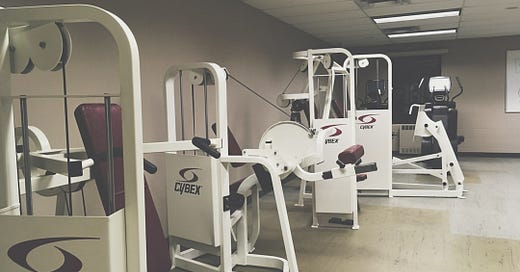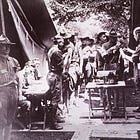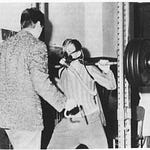
In contemporary society, we are bombarded with negative messages about men. We are told that men “toxic” and “privileged,” and we are given the impression that most men are abusers of women. In media, you will be hard pressed to find stories that talk about masculinity, and men as a group, in a positive light. Here, I want to change that. I want to highlight an unrecognized good that men have provided to the world.
Strength training, also known as resistance exercise, weight training, or weight lifting, is a form of physical activity that has been practiced since at least the time of the Ancient Greeks [1]. Typically, strength training involves placing an external resistance upon the body and lifting the load repeatedly in sets of repetitions.
In the 1940s, Dr. Thomas DeLorme introduced his system of “progressive resistance exercise” into the medical literature, providing a theoretical basis and clinical evidence for the utility of strength training in rehabilitating individuals with polio and soldiers who were injured in World War II [2]. DeLorme’s ideas led to widespread interest in, and later acceptance of, strength training as a safe and effective way to improve muscle strength and physical function after injury. Subsequent decades of research on strength training has illustrated that regular participation in this form of exercise improves various mental and physical health outcomes [3]. Today, strength training is performed by millions of people around the world for preventive and rehabilitative health purposes, including for its ability to slow the declines in muscle size and strength that occur with aging and disease.
Nevertheless, strength training cannot be completed without the external resistances that are placed onto the body. But what are these resistances? What forms do they take? Where do they come from? In other words, what is the equipment that makes strength training possible, and who conceives of it and designs it? Given that strength training provides many health benefits to individuals and thus to society, surely we should be celebrating the individuals who have made all of this possible, should we not?
In 2021, I published a paper in the Journal of Strength and Conditioning Research that documented the history of patent applications for strength training equipment [4]. Using the website Google Patents, I tracked down every patent for strength training equipment that was submitted to the United States (US) Patents and Trademark Office before 1980. I discovered that 551 patents for strength training equipment were submitted to the Office between 1860 and 1979. These patents included designs for strength training implements such as dumbbells, barbells, and Indian clubs. They also included designs for larger weight stack machines and cable-pulley systems. They also included accessory items like benches and racks.
I also examined the sex of the applicants. I found that 98.7% of all patent applications for strength training equipment were submitted by men. Thus, a good that men have brought to the world for decades, but that has gone largely unrecognized, is strength training equipment. In fact, men invent most things. A study published in 2009 found that men submit more than 85% of all patent applications across various scientific domains and countries [5].
My research also involved performing a content analysis of the patent applications to further understand men’s rationales for their inventions and how they thought their designs advanced existing equipment. My analysis revealed that over the past 160 years, men have been trying to make strength training exercise safer, more personalized, more convenient, more accessible, and ultimately more effective. I developed the mnemonic device CHAPS MANLINESS to help people remember the various aspects of the strength training experience that men have been making better with their inventions. A given invention will not embody each characteristic of the mnemonic device but it will embody many of them. Here, is the breakdown of CHAPS MANLINESS:
C: stands for compact. Men have often tried to make strength training equipment as small as is feasible, so that the equipment takes up minimal space at home, in the office, or at the gym.
H: stands for home use. Men have tried to make strength training equipment that is suitable for use at home, with the thinking that home exercise can make participation in strength training more convenient for some individuals.
A: stands for adjustability. This is one of the biggest ways in which men have advanced strength training equipment from the early days of single dumbbell or barbell loads. The reason that being able to adjust the exercise weight is important is because not all individuals have the same amount of strength. Thus, if someone cannot even lift a given dumbbell load one time, then they clearly will not receive any of the benefits of strength training. Similarly, if a given dumbbell is too light for a strong individual, then they also will not be optimizing their strength training program. Also, not all individuals have the same body heights or limb lengths. Thus, adjustable seat heights and handle positions for weight stack machines allow individuals of different body sizes to use machines in ways that optimize workout effectiveness. In sum, the concept of adjustability equates to personalization which then equates to inclusivity. That’s right – men have made strength training more accessible to individuals of various sizes and abilities. When was the last time you heard men being given credit for such an achievement?
P: stands for portability. Men have designed strength training equipment that is easier to transport from one room or location to another.
S: stands for simple. Knowing that exercise is a skill that can benefit from instruction, men have designed strength training equipment that is intended to be easy to operate.
M: stands for multiplicity. Men have designed certain pieces of strength training equipment that allow for multiple exercises to be performed. This then helps to save both cost and space, as one no longer has to buy separate machines for each individual exercise.
A: stands for aesthetics. Though not a main driver behind strength equipment innovation, men have sometimes tried to design equipment that will look more appealing to some users.
N: stands for noiseless. Some male inventors were aware that not everyone enjoys the loud clanging noises associated with dumbbells and barbells. Thus, they designed equipment that would allow for muscles to become stronger while not annoying the neighbours or others in the gym.
L: stands for light weight. Men have made some strength training equipment lighter and thus easier to transport.
I: stands for inexpensive. Men have attempted to reduce the costs associated with strength training in a variety of ways. For example, inventing a machine that allows for a multiplicity of exercises can save money compared to buying one machine for each exercise that someone wants to perform.
N: stands for no supervision. Understanding that lifting weights carries with it some risks that would be minimized by supervision during exercise, men have sought to design strength training equipment that makes supervision unnecessary. Such innovations allow individuals to exercise alone if they prefer.
E: stands for effectiveness. Men have made strength training equipment more effective at increasing muscle size and strength via a few different pathways. As mentioned earlier, men have made the resistances and the structural features of equipment more adjustable over the years. This allows for each workout to be more individualized which will then increase the potency of any exercise dose. Another aspect of effectiveness deals with how resistances are applied to the body throughout the exercise – for example, CAM-based machines attempt to match human strength curves to try to increase the potency of each repetition.
S: stands for safety. Men have made strength training equipment safer and more comfortable for people to use. Example design features that have improved exercise safety include bar collars, bar racks, and rack safety pins.
S: stands for sturdiness. Men have made strength training equipment more durable. Thus, a given piece of equipment can be used for a long period time.
The strength training equipment that we use at home or at the gym today has not always been there. It first needed to be conceived and designed. CHAPS MANLINESS summarizes how men conceived of and designed strength training equipment to make muscle-strengthening exercise safer, more accessible, more convenient, more personalized, and more effective. Men have made it possible for all individuals, including youth, the elderly, and those with physical disabilities to be able to participate in strength training. Men’s mechanical- and muscle strength-oriented intellect has made strength training more personalized and accessible to women as well.
Being aware of, and discussing, the good that men bring to society, such as their drive to invent new medical and health technologies, might help to counter current negative narratives about men and masculinity.
To end, I’d like to pay tribute to some of the specific men who have been responsible for inventing strength training equipment prior to 1980. They include Daniel Savage who, with a dumbbell patent in 1860, was the first individual to receive a patent for strength training equipment in the United States. Five years later, in 1865, both George Windship and D.P. Butler received patents for two of the earliest dumbbell designs. In the early 1900s, Alan Calvert and Eugen Sandow also became patent holders for various dumbbell and barbell designs. The most prolific inventor prior to 1980 was Lloyd Lambert Jr., who patented 10 strength training machines in the late 1970s. Jack LaLane – the television fitness guru – also patented three machines. Even Dr. Thomas DeLorme – the founder of progressive resistance exercise and the man whose ideas about strength training have served as the foundation for all strength training research conducted today – patented one apparatus for strength training exercise in 1967.
References
1. Crowther NB. Weightlifting in antiquity: achievement and training. Greece & Rome. 1977;24(2):111-20.
2. Todd JS, Shurley JP, Todd TC. Thomas L. DeLorme and the science of progressive resistance exercise. J Strength Cond Res. 2012;26(11):2913-23.
3. Westcott WL. Resistance training is medicine: effects of strength training on health. Curr Sports Med Rep. 2012;11(4):209-16.
4. Nuzzo JL. Content analysis of patents for strength training equipment filed in the United States before 1980. J Strength Cond Res. 2021;35(10):2952-62.
5. Frietsch R, Haller I, Funken-Vrohlings M, Grupp H. Gender-specific patterns in patenting and publishing. Res Policy. 2009;38:590-9.
Related Content at The Nuzzo Letter
SUPPORT THE NUZZO LETTER
If you enjoyed this information, please consider supporting The Nuzzo Letter with a one-time or recurring donation. Your support is greatly appreciated. It helps me to continue working on independent research projects and fighting for more evidence-based discourse.

















Share this post